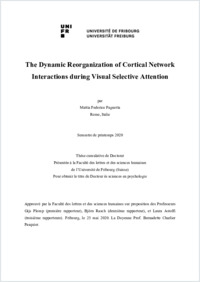The Dynamic Reorganization of Cortical Network Interactions during Visual Selective Attention
- Pagnotta, Mattia
- Plomp, Gijs (Degree supervisor)
-
2020
1 ressource en ligne (214 p.)
Thèse de doctorat: Université de Fribourg, 2020
English
Visual selective attention prioritizes the processing of behaviorally relevant over irrelevant information, to optimize the use of limited cognitive resources in the brain. These selective mechanisms preferentially route relevant neuronal representations through a network of distributed brain regions. Previous studies suggested that selective information routing in the attention network may be mediated by brain activity modulations in the alpha (α, 7–14 Hz) and beta-band (β, 15–30 Hz). However, the precise temporal dynamics of the cortical network interactions that support selective attention remain unclear. The investigation of these dynamic network interactions, given their fast and flexible nature, requires time-varying connectivity methods that can correctly estimate rapidly changing patterns of large-scale directed interactions between brain regions. While several such methods have been proposed, there is a lack of unbiased and systematic assessments of their performance and estimation accuracy. The objective of this thesis was twofold: first, to critically assess and compare the performance and estimation accuracy of time-varying directed connectivity methods; second, to provide a comprehensive characterization of the dynamic reorganization of cortical network interactions during visual selective attention, under different task demands. To systematically compare currently available time-varying directed connectivity methods, I used a combination of numerical simulations and real benchmark data recorded from rats during unilateral whisker stimulations. I showed advantages and shortcomings of the two main classes of methods, which rely on either multivariate autoregressive modeling or spectral decomposition of the recorded signals. The results served as starting point to develop innovative methods with improved performance and estimation accuracy. I employed these novel methods together with electroencephalography (EEG) source- imaging, to investigate how cortical network interactions mediate selective attention dynamically, while healthy participants discriminated the perceived motion or orientation direction of briefly presented stimuli. The results characterized the temporal dynamics of selective attention, unveiling how attention involves both local and network changes in different frequency bands, and how these modulations further depend on the specific task demands. The results provided first evidence of the role of taskspecific coupling mechanisms in supporting the selective anticipation and processing of task- relevant stimuli, through different low-frequency carriers in the β and α-band, respectively. These findings integrated into a dynamical framework existing theories of how brain rhythms establish inter-areal communication and local computation in the attention network.
- Faculty
- Faculté des lettres et des sciences humaines
- Language
-
- English
- Classification
- Psychology
- Notes
-
- Ressource en ligne consultée le 03.06.2020
- License
-
License undefined
- Identifiers
-
- RERO DOC 328530
- RERO R009047451
- URN urn:nbn:ch:rero-002-120154
- Persistent URL
- https://folia.unifr.ch/unifr/documents/308700
Statistics
Document views: 321
File downloads:
- Texte intégral: 419
